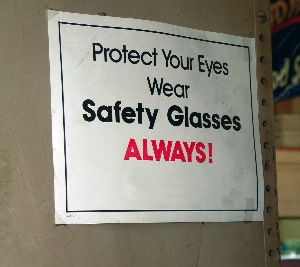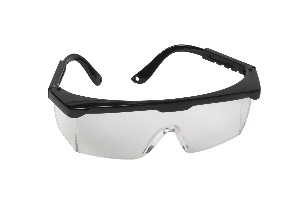Preventing Work-Related Eye Injuries
Each day, about 2,000 U.S. workers receive medical treatment because of eye injuries sustained at work. Workplace injury is a leading cause of eye trauma, vision loss, disability and blindness, and can interfere with your ability to perform your job and carry out normal activities.

Employers and workers need to be aware of the risks to sight, especially if they work in high-risk occupations. High-risk occupations include construction, manufacturing, mining, carpentry, auto repair, electrical work, plumbing, welding and maintenance. The combination of removing or minimizing eye safety hazards and wearing proper eye safety protection can prevent many eye injuries.
Personal protective eyewear, such as safety glasses with side shields, goggles, face shields and/or welding helmets, can protect you from common hazards, including flying fragments, large chips, hot sparks, optical radiation, splashes from molten metals, objects, particles and glare. The risk of eye injury and the need for preventive measures depend on the task and the conditions in your workplace.
Eye Protection on the Job
A variety of statistics emphasize the costs of workplace eye injuries to individuals, companies and society and the need for vigilance about eye safety.

• About $924 million in workers’ compensation payments were made in a recent year, according to the U.S. Bureau of Labor Statistics.
• Almost $4 billion in wages and productivity were lost in a recent year, adds the Bureau of Labor Statistics.
• Approximately 60% of workers who suffered eye injuries were not wearing proper protective eyewear.
• Vision loss is one of the top 10 workers disabilities.
“Even though the Occupational Safety and Health Administration (OSHA) now mandates protective eyewear in many workplace situations, companies and individuals need ideas like these to help employees make a habit of wearing safety glasses 100% of the time,” says Jodi Groh, director of marketing for Nanofilm, maker of Defog It antifog towelettes and liquid.
Safety Precautions
Employers can take several precautions to make the work environment as safe as possible and help reduce the risk of visual impairment and blindness caused by injury:
• Conduct an eye-hazard assessment.
• Remove or reduce all eye hazards where possible.
• Provide appropriate safety eye protection for the types of hazards at the worksite. Make eyewear straps or lanyards available. For people who move in and out of work areas requiring protective eyewear, they can keep eyewear from getting lost.
• Require all employees in hazardous situations to wear the appropriate eye protection. Review the OSHA standards for your work type. Are you providing the correct standard of protection for each work area? For example, do workers need safety glasses with side shields? Or a face mask over eyewear?
• Keep eye protection in good condition and assist workers with attaining the proper fit. Research shows 94% of eye injuries that occurred while workers were wearing eye protection were a result of particles or chemicals that entered around or under the protective shield.
• Offer multiple styles of protective eyewear so each worker can choose the best fit and most comfort. Says one employer, “I don’t want there to be any excuses for not wearing safety glasses.”
• Make sure fogged eyewear isn’t a problem. In a study published in Accident Analysis & Prevention magazine in 2009, research with focus groups made up of manufacturing, construction, service and retail workers showed that 100% of the groups named fogging as a factor for not wearing personal protective eyewear, number one among vision-related reasons. Over 55% of research respondents suggested an antifogging solution to increase usage of personal protective eyewear.
• Keep bystanders and customers out of work areas and/or behind protective barriers.
• Use caution flags to identify potential hazards such as hanging or protruding objects.
• Provide emergency sterile eyewash solutions/stations near hazardous areas.
• Post first-aid instructions and information on how to get emergency aid.
Eye safety should receive continuing attention in workplace educational programs. Procedures for handling eye injuries should also be established and reinforced.
Workers should have a comprehensive dilated eye examination on a regular basis (typically every two years) to help ensure good eye health. Maintaining healthy vision is important to avoiding injuries on the job.
Make vision a health priority, because eye safety at work is everyone’s business.
For more information on keeping your eyes healthy, visit www.nei.nih.gov/healthyeyes/.
Sources: The National Eye Institute and Nanofilm, www.defogitworks.com.
For manufacturers of Shop Safety/Personal Protection equipment, visit TechShop’s Buyer’s Guide at www.TechShopMag.com.












